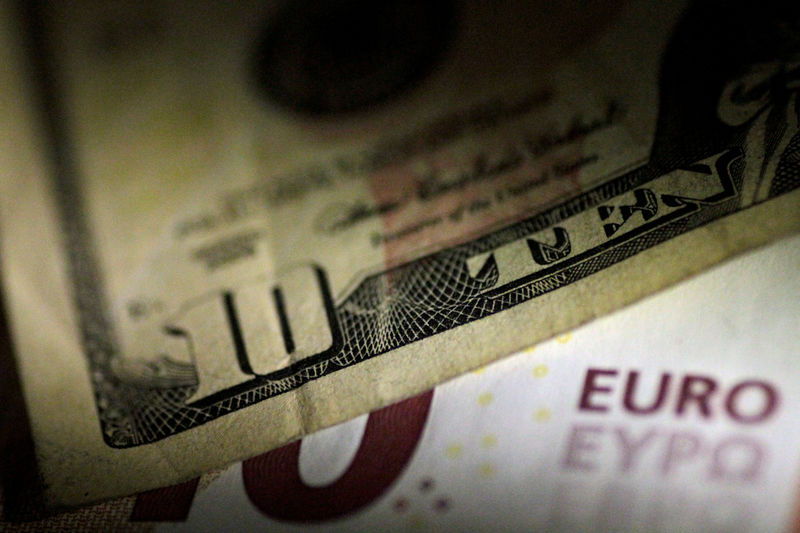 © Reuters. FILE PHOTO:Illustration photo of U.S. Dollar and Euro notes
© Reuters. FILE PHOTO:Illustration photo of U.S. Dollar and Euro notesBy Rahul Karunakar and Hari Kishan
BENGALURU (Reuters) – The U.S. dollar will retreat further over the coming year, giving way to an ascendant euro, according to a Reuters poll of strategists who said five or more Federal Reserve rate rises would be needed to significantly boost the greenback’s fortunes.
After losing 10 percent in 2017, the dollar had its best monthly run in February since November 2016 in part as solid economic data fanned expectations the U.S. central bank would raise interest rates four times this year rather than three.
But the dollar is down about 2 percent so far in 2018 and is forecast to weaken further this year, leaving the euro () at $1.28, up from around $1.24 on Tuesday, according to the March 1-6 poll of over 60 foreign exchange strategists.
Stocks, bonds and currency markets have been whipsawed over the past month on rising volatility, concerns that inflation will rise, and government borrowing will surge on the U.S. administration’s tax cuts and new increased spending plans.
Reuters polls of economists, equity strategists and analysts taken over the past few weeks have all suggested the U.S. government was wrong to cut taxes at this stage of the business cycle. [EPOLL/WRAP] [ECILT/US]
“The U.S. fiscal decisions imply that the U.S. needs to find more foreign investors, and we expect the U.S. to face stronger competition than in the past when marketing a rising debt inventory to foreign investors,” noted Thomas Flury, global head of currency strategy at UBS Group AG.
“The consequence is likely to be a falling U.S. dollar.”
Twenty-seven of 57 strategists in the latest poll said the change in the U.S. fiscal position has driven their view for a weaker dollar now. Eighteen said there was no change in their outlook and the remaining 12 respondents said the dollar will strengthen from it.
“That (fiscal stimulus) is something which will weigh on the dollar going forward,” said Lee Hardman, currency economist at MUFG. “The budget deficit and the current account deficit are both likely to widen out in the coming years and certainly start to reach levels which could be seen as more dollar-negative in the medium- to long-term.”
While rising U.S. Treasury yields pushed the dollar to a six-week high last week, the currency pulled back sharply after President Donald Trump’s decision to impose tariffs on steel and aluminum sparked fears of an imminent trade war.
Currency speculators increased their bets against the greenback to a three-week high, according to data from Commodity Futures Trading Commission on Friday.
“The fiscal impact on the U.S. cycle will be front-loaded in terms of growth, thus we believe the USD should receive some short-term support. But the trade policies could have the opposite impact in the short-term,” noted Roberto Cobo Garcia, FX strategist at BBVA (MC:).
“Thus, we maintain our expectations that the USD has limited upside potential and that risks remain tilted to the downside.”
The dollar is expected to gain significantly only if five or more Fed rate hikes are priced in, according to over 70 percent of 54 respondents who answered an additional question. The remaining 17 strategists said four would be enough.
“Given the hawkish tone of the new Fed chairman (Jerome) Powell before Congress, we would need to see more than four rate hikes coupled with a steepening in the Treasury yield curve for the USD to appreciate significantly,” added BBVA’s Garcia.
Interest rate futures markets are currently pricing in a roughly one-in-four chance of a fourth Fed hike this year.
The dollar has also lost ground as several major central banks now appear to be moving roughly in the same direction towards policy tightening, albeit at differing speeds, closing the interest rate gap with the United States.
Robust economic growth in the euro zone has driven expectations for the European Central Bank to end its over 2.5 trillion euro asset purchase program by end-year. That pushed the euro along its best rally since 2003 last year.
But the ECB is not expected to raise rates until next year at the earliest, and inflation, at least in the last few months, is moving away from the central bank’s target.
Sterling
(Other stories from the global foreign exchange poll:)
(Polling by Indradip Ghosh and Khushboo Mittal; Editing by Ross Finley and)
Source: Investing.com




























